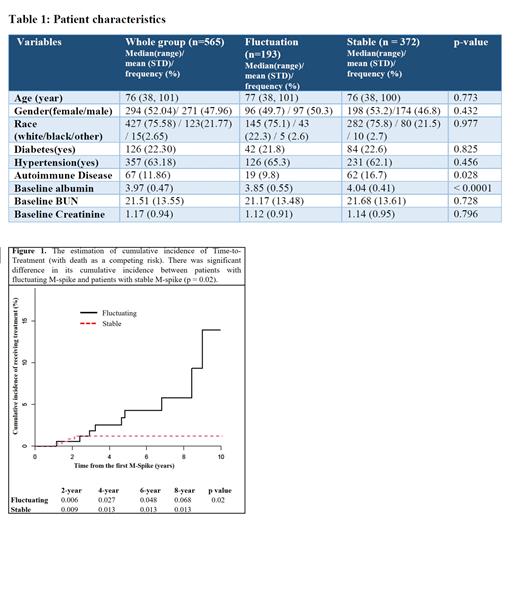Abstract
Multiple Myeloma (MM) is a cancer of terminally differentiated plasma cell resides in bone marrow, which is always preceded by clinically asymptomatic precursor states. The process of malignant transformation however is not fully understood. Analyses of cells from precursor state have provided evidence that it is a genetically advanced lesion, wherein tumor cells carry many of the genetic changes found in MM cells. Furthermore, mice xenografts from patient (pt) with precursor disease showed progressive growth on its own suggesting progression potential is counteracted by active extrinsic restraints that prevent its progression to MM (Das R et al. Nature Medicine, 2016). Hence, precursor progression to MM can be viewed as a dynamic process in which the clonal mass is the net result of pro-growth, pro-survival replicative capacity of the myeloma clones vs. anti-tumor immunity.
The change in the net clonal mass sometimes is large enough to be detected by measurable fluctuations in serum monoclonal protein spike (M-spike) levels and reflects a highly dynamic battle between plasma cell clone and cell-mediated anti-myeloma immunity among those pts. The prognostic value of this highly dynamic state on risk of progression to MM is largely unknown. In this study we sought to assess the association between the dynamic M-spike pattern and the risk of progression from a precursor clone to MM.
Methods: All pts with positive serum electrophoresis (SPEP) values measured from January 2011 to January 2021 for our institution were included for this study. All pts that had <3 M-spike readings before requiring anti-myeloma regimen, received active treatment for MM within 90 days of the first positive SPEP, had M-spike values >3g/l or had clear evidence of progression by serial increasing M-spike values were excluded.. We assigned the pattern of M-spike values over time into two groups according to stability. To eliminate the test-to-test variability, we defined stable disease as lack of more than 20% difference from lowest M-spike, and fluctuating disease if the difference exceeds 20%. The time-to-treatment (TTT) was then measured from the first positive SPEP to the time of treatment and was censored at the date of last follow-up for pts who did not have anti-myeloma treatment with death as competing risk. The effect of M-spike pattern on TTT, treating as binary outcome, was also evaluated using logistic regression analysis. Univariate analysis of TTT was performed using Gray's method. All tests were two-sided and p-value ≤ 0.05 were considered statistically significant.
Results: A total of 565 pts were studied, 193 with a fluctuating pattern and 372 with a stable pattern. Median age at first positive SPEP was 76 years old (range: 38-101), 271 (48%) of them were male; 427 (75%) were Caucasian and 123 (22%) African American. Baseline creatinine was 1.17 mg/dl (range 0.5-11.2 SD 0.94). Baseline albumin was 3.97 g/dl (range 1.6-5.2 SD 0.47), 336 pts (59%) were IgG, 75 (13%) IgA, and 142 (25%) had IgM M-spike; 326 (58%) pts had Kappa light chain and 239 (42%) had Lambda. Autoimmune diseases were more common in the stable disease pattern (17% vs. 10% p=0.028), the most frequent one was Rheumatoid arthritis in 33 pts (6%). Furthermore, baseline albumin was statistically higher in pts in the stable cohort (4.04 vs. 3.85g/dl, p=<0.0001). Median follow up was 46.9 months (range: 3.2-120.9). Logistic regression: the odds ratio (OR) of having progression to treatment for fluctuation group was 4.5 (95% CI: 1.37-14.18, p= 0.013) in comparison to stable group. Time-to-event analysis: pts with fluctuating M-spike had higher chance of needing therapy (Hazard Ratio: 3.73, 95% CI: 1.19-11.66, p=0.024) than stable group. Cumulative incidence of needing treatment is shown in Figure-1.
Conclusion: The dynamic pattern of M-spike seen here with fluctuating values over time (over time is two words) was significantly predictive of progression to MM in pts with a precursor disease state. These findings may reflect a different nature of tumor vs. immune system balance and possible impaired immunity in these pts which may have implications for future clinical trials that evaluate the efficacy of anti-myeloma immunotherapeutics. Furthermore, our finding suggest that fluctuations in M-spike levels may be factored into risk models that predict the progression to MM among pts with precursor clones. Larger studies are warranted to further study this concept.
Malek: Medpacto Inc.: Research Funding; Janssen: Other: Advisory board ; Takeda: Honoraria; Cumberland Inc.: Research Funding; Amgen: Honoraria; BMS: Honoraria, Research Funding; Bluespark Inc.: Research Funding; Sanofi: Other: Advisory Board.


